Thomas Gainsborough’s ‘Blue Boy’ Was Once the World’s Most Famous Painting—Here Are 3 Surprising Facts About It
One hundred years ago, Thomas Gainsborough’s The Blue Boy (1770) became the most expensive painting in the world when American collectors Henry and Arabella Huntington purchased the masterpiece for the then unheard-of sum of $728,000.
With the purchase, the painting—which Gainsborough had first exhibited under the name Portrait of a Young Gentlemen—reached a new height of fame on both sides of the Atlantic. Before departing London for its new California home, Gainsborough’s virtuosic depiction of a teenage boy, clad in a shimmering blue satin suit, went on display for three weeks at the National Gallery in a kind of patriotic goodbye.
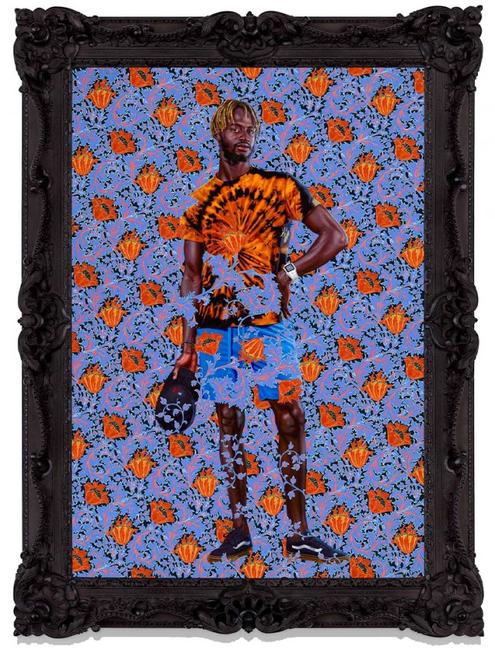
Kehinde Wiley, A Portrait of a Young Gentleman (2021). Courtesy of the Huntington Library.
In the century since that record-breaking purchase, The Blue Boy (a nickname it earned in 1798) has seen endless emulation, with references cropping up in everything from a 1927 Marlene Dietrich photo shoot to a costme reference in Quentin Tarantino’s Django Unchained. Earlier this year, Kehinde Wiley, who took art classes at the Huntington Library as a child, unveiled his A Portrait of a Young Gentleman, a response to Gainsborough’s iconic painting commissioned to hang across from the Gainsborough at the library. Wiley’s vision of a teenage boy in sneakers and shorts amid swirls of blue botanicals is at once an ode to and a critique of its 18th-century counterpart.
Now, this January, for the first time since departing the U.K. a century ago, The Blue Boy will return to London’s National Gallery for a landmark exhibition that will showcase the painting alongside works by Anthony Van Dyck and other artists from whom Gainsborough took inspiration.
Ahead of this historic exhibition, we decided to take a closer look at Gainsborough’s Blue Boy and have found three fascinating facts that might just change the way you see it.
Gainsborough Painted It to Be “Cool”
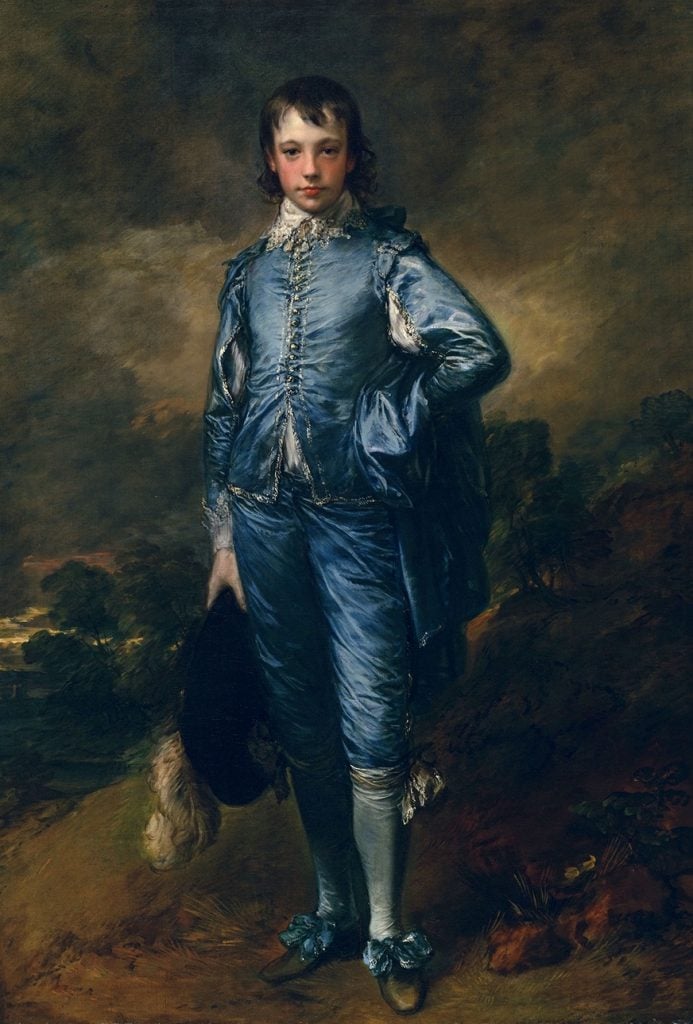
Thomas Gainsborough, Blue Boy (1770). Courtesy of the Huntington Library.
While that shimmering blue suit is certainly the most beloved aspect of Gainsborough’s portrait it is also what made it so unconventional in its day. Gainsborough debuted The Blue Boy at the Royal Academy in 1770 at a time when its founder, Joshua Reynolds, was taking cues from the great Roman and Florentine artists who emphasized warm tones of red. Gainsborough, on the other hand, took a quite literally cooler approach to painting, emphasizing blue and green tones in his portraits.
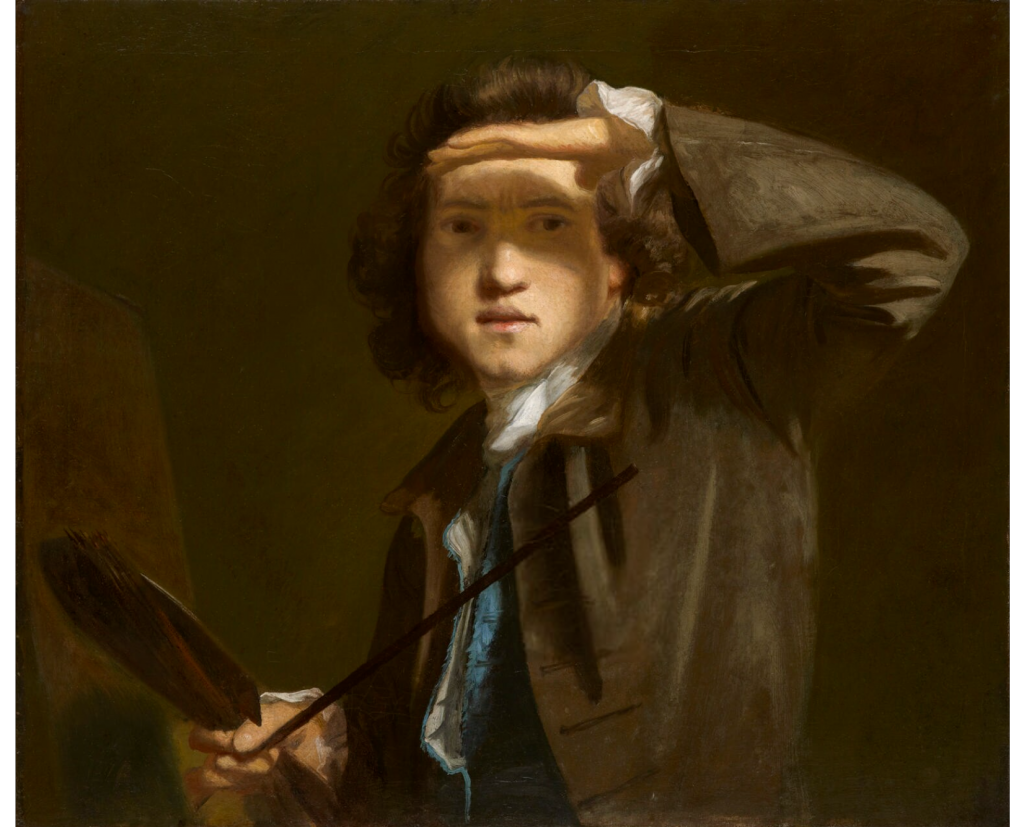
Sir Joshua Reynolds’s Self-Portrait (circa 1747–1749) exemplifies his approach to cool tones as sparingly used accents. Courtesy of the National Portrait Gallery.
One particularly indefatigable rumor has it that Gainsborough painted The Blue Boy to directly refute Reynolds’ “Eighth Discourse,’ in which the academician declared that blue tones were better off as accent colors.
“It ought, in my opinion, to be indispensably observed, that the masses of light in a picture be always of a warm, mellow color, yellow, red, or a yellowish-white, and that the blue, the gray, or the green colors be kept almost entirely out of these masses, and be used only to support or set off these warm colors,” Reynolds wrote.
While this anecdote certainly crystallizes two diametrically opposed artistic perspectives, it ignores the fact that Reynolds only presented these views to the Academy in 1778, some eight years after Gainsborough completed his masterpiece.
Nevertheless, The Blue Boy does embody Gainsborough’s highly original and modern approach to portraiture—and one that was at odds with Reynolds. Blue, when used dominantly in any painting up to this point, had been relegated almost entirely to the backgrounds of canvases (think the celestial blues of heavens). Here, however, Gainsborough places it front and center. The contemporaneity of Gainsborough’s approach is only further underscored by his use of Prussian blue—the first artificially manufactured color, which was first produced in 1704.
The Painting Captures an 18th-Century Trend for Old-Fashioned Dress-Up
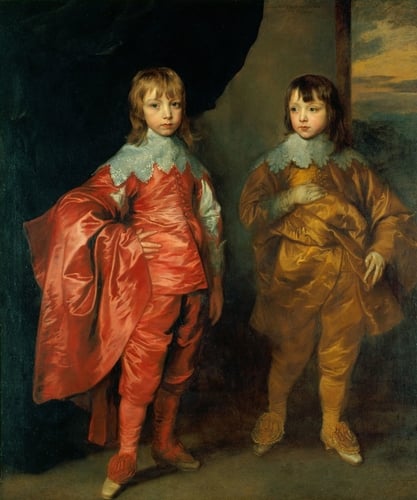
Anthony Van Dyck, George Villiers, 2nd Duke of Buckingham (1628-87), and Lord Francis Villiers (1629-48) (inscribed 1635). Courtesy of the Royal Collection Trust.
Costume historians will be keen to point out that Blue Boy’s famed ensemble isn’t in keeping with the fashions of the 1770s, but was more suited to styles of 130 years earlier, the 1640s. The Blue Boy appears to wear garb straight out of a portrait by Gainsborough’s hero, Anthony Van Dyck, and indeed many have interpreted the painting as Gainsborough’s homage to Van Dyck, particularly his shimmering double-portrait of the young duke George Villiers and Lord Francis Villiers.
Van Dyck’s portrait was famous in its own time for its luster and sensitivity, and the painting was known to be highly influential to a number of 18th-century artists, including Gainsborough. Van Dyck’s influence on Blue Boy is not only apparent in the young subject’s stance, but also in the luminous costume.
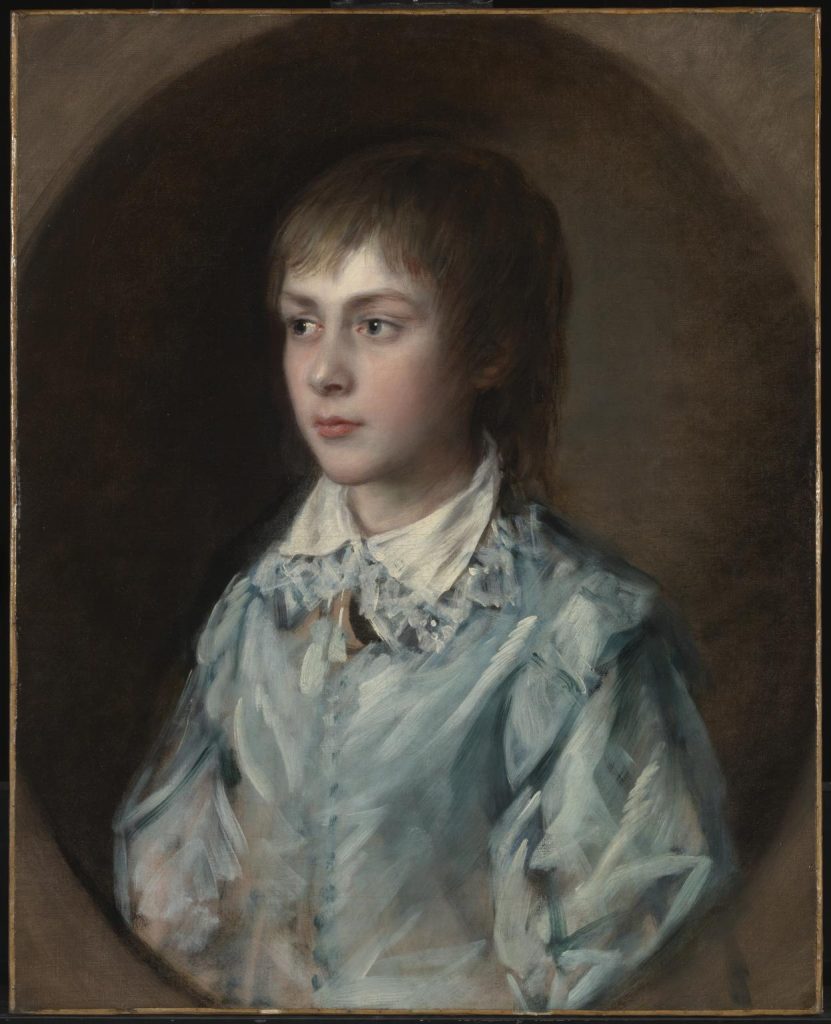
Thomas Gainsborough, Edward Richard Gardiner (circa 1760–68). Courtesy of the Tate.
While it might seem odd for Gainsborough, who was against nostalgic classicizing, to paint his subject in anachronistic garments, it was actually very contemporary. Dressing up in old-fashioned masquerade costumes for portraits was a popular trend in 1770s England (think of it as a precursor those kitschy “Old West” saloon photographs).
Here, the Blue Boy, who many believe to be Jonathan Buttall, the son of a wealthy hardware merchant an an acquaintance of the artist, is shown as an aristocrat donning 17th-century cavalier attire with white stockings and blue satin breeches with lavishly gold embroidery.
Though the ensemble earned iconic status in his painting, Gainsborough, in fact, utilized the same exact costume in several other portraits, including those of both his nephews Edward Richard Gardiner and Gainsborough Dupont (some think Dupont model for this portrait as well). The portrait of Gardiner, which Gainsborough finished in 1768, is believed by historians to have been the artist’s “trial of color” before embarking on his Blue Boy.
A Dog Is Disguised Beneath the Painting’s Surface
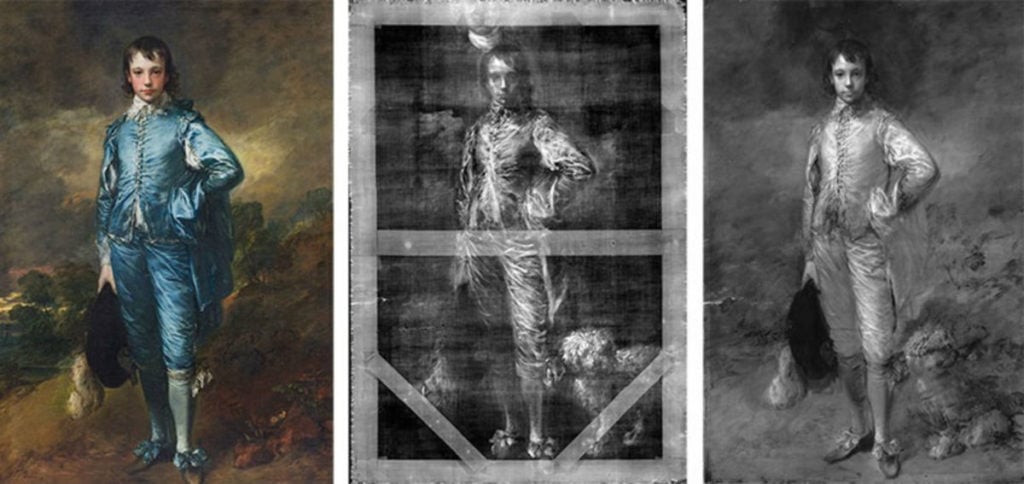
Thomas Gainsborough, The Blue Boy (ca. 1770) shown in normal light photography (left), digital x-radiography (center, including a dog previously revealed in a 1994 x-ray), and infrared reflectography (right).The Huntington Library, Art Collections, and Botanical Gardens.
Some 250 years after its creation, the luminous lusters and hues of The Blue Boy had dimmed and faded. With the aim of restoring the painting to its full azure allure (as well as stabilizing it against further degradation), the Huntington recently completed its Project Blue Boy, an 18-month restoration project led by conservator Christina O’Connell and curator Melinda McCurdy. The comprehensive, and incredibly well documented, restoration revealed some fascinating insight into Gainsborough’s process.
Most revelatory (at least to dog lovers), were the x-rays showing that Gainsborough had actually included a fluffy white pup at the boy’s left. The artist later concealed and replaced the dog with a pile of rocks. (Gainsborough also apparently painted over the sketch of an older man in the portrait). While a 1994 x-ray first revealed the pooch behind the painting, new infrared reflectography images granted insight into just how Gainsborough covered up the dog.
“We can see how he very intentionally added layers on top of it to hide it into the landscape. He turned the dog’s paws into rocks,” O’Connell told the Los Angeles Times. Historians believe it may be an English water spaniel.
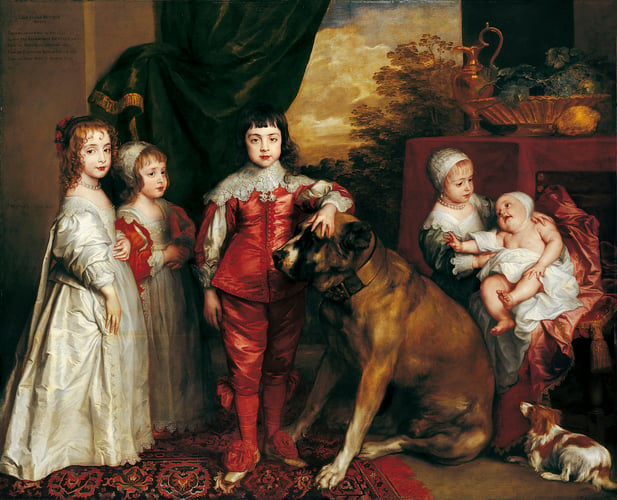
Anthony Van Dyck, The Five Eldest Children of Charles I (Signed and dated 1637). Courtesy of the Royal Collection Trust.
Why do away with man’s best friend? While no one is certain, Gainsborough might have had second thoughts about the dog’s aesthetic contributions to the portrait. In a 1995 interview with the Los Angeles Times, curator Shelley Bennett speculated on the decision: “It works compositionally. Probably it was just the concept,” she said. “I think the dog was so cute, so adorable—it’s a pooch—that it undercut the aristocratic conceits of the painting. Or maybe Gainsborough thought all that fluff fought with the boy’s hat.”
Perhaps Gainsborough felt he was a little too closely looking at Van Dyck, whose portraits of royal children so often did include their canine companions—or maybe that his didn’t measure up.
Follow Artnet News on Facebook:
Want to stay ahead of the art world? Subscribe to our newsletter to get the breaking news, eye-opening interviews, and incisive critical takes that drive the conversation forward.
Credit: Source link